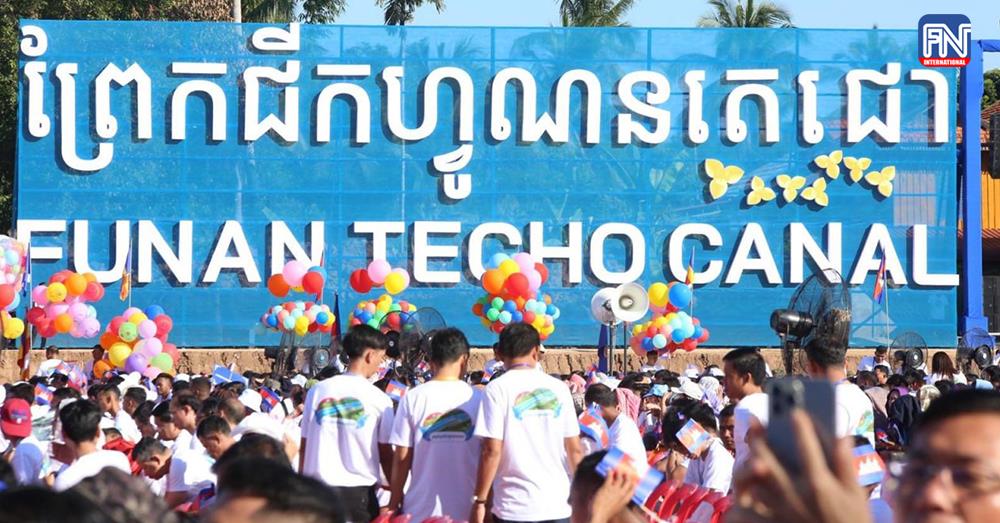Phnom Penh (FN), Dec. 18 – The Mekong region has emerged as a strategic theatre in the intensifying rivalry between the United States and China due to its critical geographical and economic importance. With vital waterways, abundant natural resources, and rapidly developing economies, the Mekong is crucial for trade and growth in Southeast Asia. Infrastructure projects like Cambodia's Funan Techo Canal have increased its geopolitical importance, drawing attention to how such developments may impact regional power dynamics and stability. The canal, intended as a major economic corridor, risks being viewed as a dual-use asset, serving both commercial and military functions, given its strategic location near contested maritime areas and its design to accommodate larger vessels. These features raise concerns about the canal's potential militarization and its role in shifting regional power. The Funan Techo Canal is central to Cambodia's economic ambitions, aiming to enhance industrial zones, production lines, and supply chains, particularly in logistics, agriculture, and aquaculture, in line with Cambodia's goals of becoming an upper-middle-income country by 2030 and a high-income country by 2050. Cambodia must carefully navigate this complex situation to protect its sovereignty while maximizing economic growth.
Strategic Importance of the Canal and The U.S. Concerns
The Funan Techo Canal presents an opportunity for China to expand its economic and strategic influence in Southeast Asia, further connecting Cambodia to its regional network. However, the development of dual-use infrastructure, such as the canal, is often scrutinized in the context of U.S.-China competition, especially given examples like the controversy surrounding the Ream Naval Base. The canal, which would connect the Gulf of Thailand to the South China Sea, could significantly shorten shipping routes and potentially alter regional trade flows. The U.S., concerned about these developments, sees the Mekong sub-region as a crucial area for countering China's influence, as demonstrated by its growing cooperation with Vietnam and other ASEAN countries through initiatives like the Mekong-U.S. Partnership.
The U.S. views control over strategic sea lanes as essential for preserving its influence and military presence in the Asia-Pacific. China's expanding political and economic reach in Cambodia, through investments like the Belt and Road Initiative (BRI), has raised concerns among U.S. policymakers. They fear that Cambodia, under China's sway, could become a base for Chinese military and strategic operations, undermining U.S. interests. The canal's strategic location, if used for military or dual purposes, could strengthen China's ability to project power in the region. There are worries that it might transform into a "naval base" or support military logistics, increasing China's presence in the South China Sea, a sensitive area for U.S. security.
U.S. officials, including Secretary of State Antony Blinken, have voiced concerns about the potential military implications of Chinese investments in Cambodia. The U.S. has raised alarms about the possibility of China establishing a military presence in Cambodia. In response, the U.S. has increased military aid and joint exercises with regional partners like Vietnam and the Philippines to counter China's growing military footprint in Southeast Asia. The U.S. has also proposed alternative infrastructure and defense support to Cambodia as a countermeasure to its deepening ties with Beijing. Additionally, the U.S. continues to engage diplomatically with Cambodia, urging it to balance its relationship with China and uphold international norms and sovereignty, particularly in relation to the South China Sea.
The U.S. concerns over the Funan Techo Canal form part of a broader strategy to counter China's influence in Southeast Asia, aiming to maintain regional balance, protect vital maritime routes, and promote democratic governance and security in the region.
Reflections on External Criticism
Number of articles written by Western researchers and journalists underscored growing external scrutiny of Cambodia's political trajectory and its alignment with China, presenting the nation as resistant to criticism and overly dependent on Chinese influence. These narratives, predominantly advanced by some Western journalists and analysts, questions Cambodia's ability to act as an independent player in regional geopolitics. The framing of Cambodia as reliant on China reflects broader concerns about its sovereignty and decision-making amid escalating U.S.-China tensions. These publications appear designed to provoke discussions about Cambodia’s foreign policy and its sensitivity to international critiques, serving as both a warning and a critique of its current path.
In this context, opposition leader Sam Rainsy has raised alarm over Cambodia’s increasing dependence on Chinese loans and aid. On May 23, 2024, Rainsy published an article in Nikkei Asia describing the Funan Techo Canal as a de facto outpost for the Chinese Navy. He cited satellite imagery analyzed by the Asia Maritime Transparency Initiative, part of the Center for Strategic and International Studies in Washington, claiming it shows two Chinese warships stationed at Ream Naval Base since early December. Rainsy further suggested that Beijing is pushing for the canal—with a width of up to 100 meters and a depth of 5.4 meters—for potential use by the Chinese military to attack Vietnam from an alternative direction in a conflict scenario. These claims align with broader Western narratives warning of Cambodia's alleged erosion of sovereignty and the canal's potential role in advancing China's military objectives in Southeast Asia.
However, Cambodian Prime Minister Samdech Thipadei Hun Manet has refuted these claims, labeling them baseless and harmful. He argued that such accusations only serve to heighten tensions and provoke radical behavior among Cambodia’s youth, undermining national unity. Hun Manet emphasized the canal's role as a critical infrastructure project designed to enhance Cambodia’s economic sovereignty. He stated that the project would allow Cambodia to “breathe through our own nose,” reducing reliance on foreign shipping routes and lowering transport costs by up to 20%. This, in turn, would help ensure that Cambodian exports remain competitively priced, benefiting consumers and strengthening the nation’s economic resilience.
Cambodia’s Strategic Dilemma
Cambodia faces a challenging balancing act. Its strong economic ties with China, particularly through the BRI, provide substantial benefits but also draw criticism for perceived over-reliance. Simultaneously, pressure from the U.S. and regional neighbors like Vietnam to ensure transparency and neutrality in its infrastructure projects is mounting. How Cambodia addresses the strategic concerns surrounding the canal will significantly impact its relations with both superpowers and its standing in ASEAN. Cambodia can adopt several a few pragmatic strategies to mitigate the geopolitical risks associated with the Funan Techo Canal:
Firstly, Cambodia must assert more neutrality to mitigate geopolitical concerns, Cambodia must assert the canal’s status as a sovereign infrastructure project dedicated to economic development. By communicating consistently and transparently about the canal’s purely civilian purpose, Cambodia can address fears of potential militarization and reassure both domestic and international stakeholders. Engaging with ASEAN also help Cambodia to establish regional guidelines for the use of critical waterways. Through fostering collective responsibility and promoting transparency, Cambodia can help to alleviate regional apprehensions about the canal’s strategic implications while reinforcing ASEAN’s role as a stabilizing force.
Secondly, reducing dependency on China by seeking more investment and collaboration from countries like Japan, South Korea, and the European Union, Cambodia can present the canal as a multilateral initiative, thereby balancing its partnerships and avoiding over-reliance on any single power. Last but not least, Cambodia must strengthen national maritime and security oversight that will enable Cambodia to retain full control over the canal’s operations. This ensures that the project remains firmly civilian in nature and demonstrates Cambodia’s commitment to sovereignty and transparency.
Conclusion
The Funan Techo Canal’s development is a litmus test for Cambodia’s ability to navigate great-power competition. By prioritizing neutrality, engaging ASEAN, diversifying partnerships, and ensuring sustainability, Cambodia can maximize the canal’s economic potential while minimizing geopolitical risks. Simultaneously, the government must address perceptions of opacity and over-alignment with China to bolster its regional credibility. As Southeast Asia’s strategic importance grows, the canal’s trajectory will serve as a critical barometer for the region’s future stability and prosperity. To prevent interference, Cambodia must balance assertive domestic governance with inclusive diplomacy. By building national unity, maintaining policy transparency, and engaging in strategic multilateralism, the government can mitigate external pressures while safeguarding the country’s sovereignty and development objectives.
Thong Mengdavid- Geopolitical and Security Analyst
=FRESH NEWS





